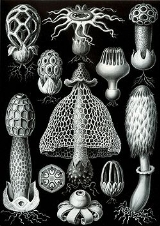
Basidiomycota
Overview
Basidiomycota is one of two large phyla
that, together with the Ascomycota
, comprise the subkingdom Dikarya
(often referred to as the "higher fungi") within the Kingdom Fungi. More specifically the Basidiomycota include these groups: mushroom
s, puffball
s, stinkhorns, bracket fungi
, other polypore
s, jelly fungi, bolete
s, chanterelles
, earth stars
, smuts
, bunts
, rusts
, mirror yeasts, and the human pathogenic yeast Cryptococcus
. Basically, Basidiomycota are filamentous fungi composed of hypha
e (except for yeasts), and reproducing sexually via the formation of specialized club-shaped end cell
s called basidia
that normally bear external meiospore
s (usually four).
Phylum
In biology, a phylum The term was coined by Georges Cuvier from Greek φῦλον phylon, "race, stock," related to φυλή phyle, "tribe, clan." is a taxonomic rank below kingdom and above class. "Phylum" is equivalent to the botanical term division....
that, together with the Ascomycota
Ascomycota
The Ascomycota are a Division/Phylum of the kingdom Fungi, and subkingdom Dikarya. Its members are commonly known as the Sac fungi. They are the largest phylum of Fungi, with over 64,000 species...
, comprise the subkingdom Dikarya
Dikarya
Dikarya is a subkingdom of Fungi that includes the phyla Ascomycota and Basidiomycota, both of which in general produce dikaryons, may be filamentous or unicellular, but are always without flagella. The Dikarya are most of the so called "higher fungi", but also include many anamorphic species that...
(often referred to as the "higher fungi") within the Kingdom Fungi. More specifically the Basidiomycota include these groups: mushroom
Mushroom
A mushroom is the fleshy, spore-bearing fruiting body of a fungus, typically produced above ground on soil or on its food source. The standard for the name "mushroom" is the cultivated white button mushroom, Agaricus bisporus; hence the word "mushroom" is most often applied to those fungi that...
s, puffball
Puffball
A puffball is a member of any of several groups of fungus in the division Basidiomycota. The puffballs were previously treated as a taxonomic group called the Gasteromycetes or Gasteromycetidae, but they are now known to be a polyphyletic assemblage. The distinguishing feature of all puffballs is...
s, stinkhorns, bracket fungi
Bracket fungus
Bracket fungi, or shelf fungi, among many groups of the fungi in the phylum Basidiomycota. Characteristically, they produce shelf- or bracket-shaped fruiting bodies called conks that lie in a close planar grouping of separate or interconnected horizontal rows...
, other polypore
Polypore
Polypores are a group of tough, leathery poroid mushrooms similar to boletes, but typically lacking a distinct stalk. The technical distinction between the two types of mushrooms is that polypores do not have the spore-bearing tissue continuous along the entire underside of the mushroom. Many...
s, jelly fungi, bolete
Bolete
A bolete is a type of fungal fruiting body characterized by the presence of a pileus that is clearly differentiated from the stipe, with a spongy surface of pores on the underside of the pileus...
s, chanterelles
Cantharellus
Cantharellus is a genus of popular edible mushrooms, commonly known as chanterelles . They are mycorrhizal fungi, meaning they form symbiotic associations with plants, making them very difficult to cultivate...
, earth stars
Geastraceae
The earthstars are the family Geastraceae of gasterocarpic basidiomycetes . It includes the genera Geastrum and Myriostoma. About sixty-four species are classified in this family, divided among eight genera....
, smuts
Smut (fungus)
The smuts are multicellular fungi, that are characterized by their large numbers of teliospores. The smuts get their name from a Germanic word for dirt because of their dark, thick-walled and dust-like teliospores. They are mostly Ustilaginomycetes and can cause plant disease...
, bunts
Common bunt
Common bunt, also known as stinking smut and covered smut is a disease of both spring and winter wheats. It is caused by two very closely related fungi, Tilletia tritici and T. laevis Common bunt, also known as stinking smut and covered smut is a disease of both spring and winter wheats. It is...
, rusts
Rust (fungus)
Rusts are plant diseases caused by pathogenic fungi of the order Pucciniales. About 7800 species are known. Rusts can affect a variety of plants; leaves, stems, fruits and seeds. Rust is most commonly seen as coloured powder, composed off tiny aeciospores which land on vegetation producing...
, mirror yeasts, and the human pathogenic yeast Cryptococcus
Cryptococcus
Cryptococcus is a genus of fungus. Species grow in culture as yeasts. The perfect forms or teleomorphs of Cryptococcus species are filamentous fungi in the genus Filobasidiella...
. Basically, Basidiomycota are filamentous fungi composed of hypha
Hypha
A hypha is a long, branching filamentous structure of a fungus, and also of unrelated Actinobacteria. In most fungi, hyphae are the main mode of vegetative growth, and are collectively called a mycelium; yeasts are unicellular fungi that do not grow as hyphae.-Structure:A hypha consists of one or...
e (except for yeasts), and reproducing sexually via the formation of specialized club-shaped end cell
Cell (biology)
The cell is the basic structural and functional unit of all known living organisms. It is the smallest unit of life that is classified as a living thing, and is often called the building block of life. The Alberts text discusses how the "cellular building blocks" move to shape developing embryos....
s called basidia
Basidium
thumb|right|500px|Schematic showing a basidiomycete mushroom, gill structure, and spore-bearing basidia on the gill margins.A basidium is a microscopic, spore-producing structure found on the hymenophore of fruiting bodies of basidiomycete fungi. The presence of basidia is one of the main...
that normally bear external meiospore
Meiosis
Meiosis is a special type of cell division necessary for sexual reproduction. The cells produced by meiosis are gametes or spores. The animals' gametes are called sperm and egg cells....
s (usually four).
Unanswered Questions

